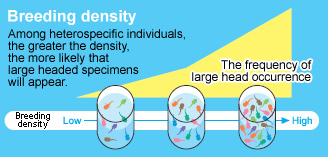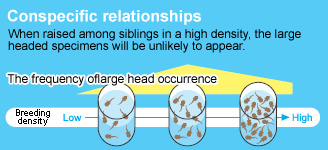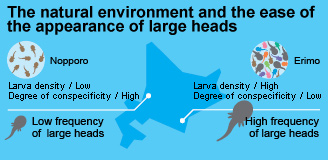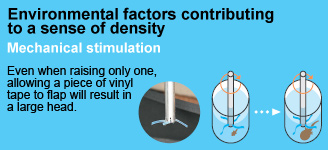|
|
Raising Ezo salamander larvae in a high density environment will result in the occurrence of large heads and developed jaws, and cannibalism will begin. When changes in the phenotype are environmentally dependent, this is called phenotypic plasticity. The large head is an advantageous plasticity for survival in overcrowded conditions. When we raised eggs taken from different ponds together, the frequency of occurrence increased with the density. In contrast, the occurrence of large heads was suppressed when the density of siblings born from the same egg pouch was exceeded the certain density. We examined the natural habitat of the Ezo salamander throughout Hokkaido. With the large populations that inhabit large ponds in Erimo, there is a small certainty of encountering siblings because they are widely dispersed, despite the high density. In contrast, Nopporo has small populations in small ponds. Even though the density is low, there is a high degree of conspecificity. Though raised in the same conditions, the eggs taken at Erimo are more likely to grow large heads, while those taken at Nopporo are not so likely to have that occurrence. The phenotypic plasticity that senses the developmental density and avoids conspecific cannibalism is thought to be a survival strategy of the Ezo salamander living in diverse environments. The mechanism by which the larvae recognize conspecificity is unclear, but large heads can be induced simply by moving a piece of vinyl tape resembling a tail using a motor. Therefore, we found that there is a mechanical stimulation for one environmental factor that causes an awareness of density. We want to continue our research linking evolution, generation, and ecological system from the phenotypic plasticity that indicates the manner of living of organisms is determined by the interrelationship of the environment and the genome. |



